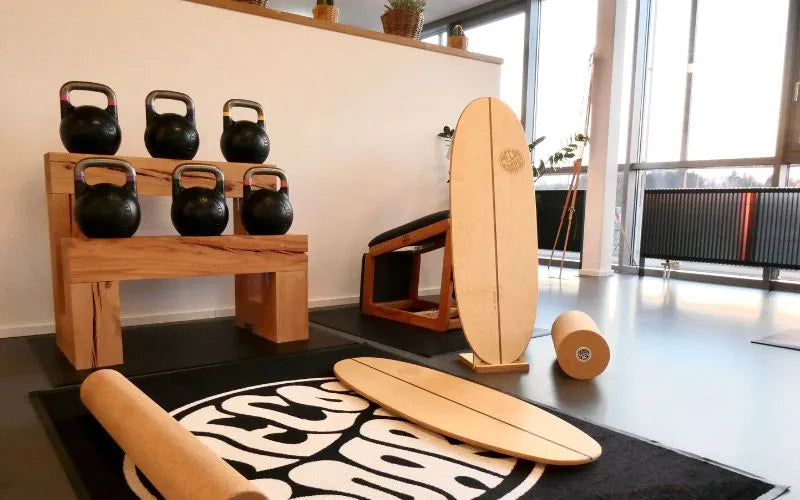
EFFECTIVE TRAINING FORMAT FOR BODY BALANCE
Balance Boarding: A diverse and effective training format for all ages. Balance Boarding is more than just a trendy and fun sport—it offers a diverse and effective training format that caters to a wide range of interests and age groups. As founders of MECOS BOARDS, we are both athletically and entrepreneurially convinced of the effectiveness of our balance board concept.
Our orthopedic expert partner Ricardo Morgado supports balance boarding as the ultimate training format for a broad audience from an orthopedic perspective. Ricardo is the owner of Physiotherapie Atlantico GmbH, an expert in sports science and physical education, and a former coach of the Swiss men's national handball team and the Portuguese national enduro team at the International Enduro Six Days race.

Find your perfect balance board in our guide
Incorporating balance boarding into your workout routine can be highly beneficial for improving balance, coordination, and stability. Whether you're a professional athlete, fitness enthusiast, or simply looking for a fun and effective way to stay active, balance boarding offers a dynamic and versatile training method that can help you achieve your desired goals.
Physiotherapist answers the 8 most important questions:
Balance training: What does it trigger in the body and what prerequisites are needed?
Balance training falls under the category of proprioceptive training, which involves all of the body's senses. Proprioceptors in muscles, tendons, ligaments, and joints send information to the brain to subconsciously perceive the body's position, posture, and position and make appropriate adjustments.
Which muscles are used during balance training?
Balance training isn't just about training individual muscle groups. Rather, the goal is to promote the interaction of all senses and the resulting physical responses. Balance training not only strengthens specific muscle groups but also improves coordination, stability, and body awareness.
Why are balance boards often used in rehabilitation and physiotherapy after injuries?
Proprioceptive training has proven to be an effective method for reducing the risk of injury. For this reason, balance training is particularly suitable for patients with foot and knee injuries who have already returned to full function but still need to work on their fine motor skills. The added fun factor also makes the training particularly attractive and motivating.
How is a movement sequence transmitted from the brain to the muscles when balancing on the board?
The proprioceptors in the muscles, tendons, ligaments, and joints receive sensory information and transmit it to the brain via the alpha motor neuron in the spinal cord. The information then travels back to the corresponding muscle groups. Not all information reaches the brain; some is already captured in the spinal cord and transmitted back to the muscles. These processes are part of proprioceptive training and contribute to improving body awareness and coordination.
How does loss of balance affect the muscles and how do the muscles react to it?
Fast and accurate transmission of information is crucial to minimize the risk of injury. Perfect muscle coordination enables flawless movements. Age, neurological disorders, and alcohol can impair proprioceptive abilities, so an optimal system is essential. If one part of the system no longer functions properly, exercises like balancing can become very difficult.
For which target group is balance board training suitable?
Age plays a minor role in the ability to perform proprioceptive training. Existing proprioceptive skills are more important. It's pointless to put a young child on a balance board if they can't even stand on one leg. On the other hand, a fit and coordinated 60-year-old can certainly benefit from balance board exercises.
How often and how long should you do balance training per week for an individual workout?
Proprioceptive training is typically performed in short sets lasting no longer than one minute. It is an intensive training method and should be performed daily in several short series to improve proprioception.
Closing words: Why do you, Ricardo, rely on balance training for patients in your physiotherapy and what makes this training method so effective?
As a physical therapist, it's extremely important to me to offer my patients a variety of different exercises as part of proprioceptive training. This training is mandatory for almost all patients in my practice, as it reduces the risk of subsequent injuries and thus better prepares them for everyday life. Proprioceptiveness is quickly lost after surgery, which is why balancing is often incorporated into the rehabilitation program.
Balancing as a training method is enjoyable for most patients and helps them connect the tough training with a positive experience. As a physical therapist, it's also rewarding for me to see my patients make progress and improve their proprioceptive skills. Therefore, I recommend doing proprioceptive training like balancing regularly in short series to maximize results.
